Lingual Braces vs. Invisalign: Which Is Better?

As modern technology has advanced, so have the opportunities to straighten teeth in a multitude of ways. Because of this, lingual braces and Invisalign have become popular options for orthodontic care due to their discretion and near-invisibility. While lingual braces have brackets and wires attached to the backside of the teeth, Invisalign offers braces-free care with the use of clear, removable aligners. Both options have their pros and cons, and should be chosen upon an individual’s needs and wants. Find out whether lingual braces or Invisalign is the best option for your orthodontic needs with this guide!
What Are Lingual Braces?
Millions of teenagers and adults have braces put on each year, and most pick the traditional metal braces that we’re all so used to seeing. However, traditional braces can be bulky, annoying and embarrassing for teenagers and adults alike, and many patients feel like they’re distracting. Lingual braces are another option for patients who prefer invisible treatment over big, bulky braces, plus they can achieve the same straight, beautiful teeth that other treatments provide. Instead of wearing braces on the outside of teeth, lingual braces attach the brackets and wires to the backside (lingual side) of teeth for an inconspicuous and nearly-invisible treatment. Other than aesthetic concerns, patients opt in for lingual braces as they make it easier to play wind instruments, such as the flute or tuba, and they’re more functional for athletes that play contact sports. However, not every orthodontic office offers lingual braces; orthodontists have to complete specialized training to be able to install lingual braces, so you’ll have to do your research to find out who in your area is qualified to perform treatment.
Additionally, lingual braces can take longer to get used to since they’re on the backside of your teeth, close to your tongue. They can make swallowing more difficult as the tongue can’t thrust between your teeth as easily as it could before. Patients also have to have long enough teeth to provide enough room for the braces to be glued onto them, so children and those with small teeth typically don’t qualify for this type of treatment. Lastly, treatment time is usually longer with lingual braces than traditional braces. The entire process depends on your orthodontist and how well you take care of your teeth during treatment, so treatment time varies from patient to patient.
How Invisalign Works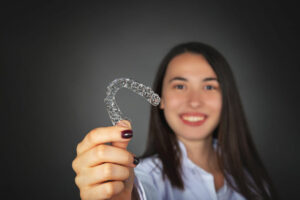
Another option for patients who prefer invisible orthodontic care is Invisalign, which uses clear, removable aligners to fix malocclusion over a period of several months or years. Some patients highly dislike the look of metal braces, lingual or not, and Invisalign offers them the care they need without having to sacrifice their confidence at work or social events. Many enjoy Invisalign because its unique treatment allows them to remove their orthodontic device during eating, drinking, flossing and brushing, making these daily activities much more manageable. They let you eat all of your favorite foods, you can’t break a wire or bracket, oral hygiene isn’t hindered and they’re virtually invisible.
Wearing Invisalign retainers does take time, effort and patience, however. One aligner is worn for one to two weeks before replacing it with the next one in line. You’ll have a checkup every six to eight weeks to monitor your teeth and receive a new batch of aligners to wear for the next several weeks. During this time, Invisalign aligners need to be worn for 20-22 hours of the day, which is a huge commitment for busy people. Aligners also need to be carefully washed and cleaned with a toothbrush each night to keep bacteria from growing. Since they’re removable, Invisalign aligners can be easily lost, misplaced or broken by a fall or child, so extreme care will be necessary to keep them intact.
Making A Choice
Both lingual braces and Invisalign are viable options for patients who want orthodontic care that is undetectable and discreet, but whichever you choose is up to you and your orthodontic needs. The first step that you’ll need to take is to visit with your orthodontist for an evaluation of your teeth and to discuss which of the two would work best for your wants and needs, plus the orthodontist’s recommendation. Remember that while Invisalign is a great option for those who want to take their orthodontic care into their own hands, it requires extreme responsibility and care for the aligners you’ll be using. Lingual braces, on the other hand, will always remain in your mouth, so you won’t need to worry about losing anything like you do with Invisalign, but flossing and brushing can be more difficult as you’ll have to do it all from the backside of your teeth. Your choice should be based on what you are willing and not willing to do during treatment, so do your research on both options to be fully informed on what to expect.
Schedule Your Consultation
To be evaluated for lingual braces or Invisalign, call Belmar Orthodontics at (303) 225-9016 to schedule a consultation. Our team is qualified and experienced at installing both lingual braces and Invisalign, plus we can give you extra tips on how to keep your teeth brilliant and healthy during treatment. Call today to start your journey to a more beautiful smile!
What Foods Should You Eat With Braces?

Whenever you first begin orthodontic treatment, your orthodontist will recommend certain foods that you should avoid, and those which will be good for your teeth. Many times, sugary or sticky foods like candy, gum, corn, and nuts shouldn’t be eaten during the duration of your treatment as they are known to damage braces and increase the likelihood of cavities. While there is a list of foods that you should NOT eat with braces, there are plenty of options that you can still include in your diet that are just as tasty as those that you will have to avoid for a while. Find out what foods you should avoid during orthodontic treatment and what foods you can still enjoy with this guide!
Foods That Are Good
One of the first concerns that patients have as they begin orthodontic treatment involves the food they should and should not eat. A lot of responsibility comes with braces, as you will have to protect them by watching what you eat, cleaning them daily and adhering to your orthodontist’s instructions. To begin, let’s discuss all of the food that you CAN eat during your time with braces. Softer options are your way to go as your mouth gets used to braces, so eating food like chicken, oatmeal, rice, beans, fish, eggs and yogurt are great ways to get a lot of nutrition without breaking a bracket. Even hard fruits, like apples and pears, are good to eat as long as they’re cut into slices or smaller pieces. Don’t think you’ll be able to get away with not eating vegetables during treatment-even the crunchiest of vegetables can be steamed or sliced into slivers, making them perfectly edible for orthodontic patients. You’ll want to eat foods that you don’t need to chew much, especially after an adjustment. Soups and mashed potatoes work perfectly for a sore mouth, and sandwiches and salads (without nuts) can be eaten once you get used to the feel of braces.
Foods To Avoid
Unfortunately, the list for foods that you should avoid during treatment seems to always be much longer than those you should eat. However, the new diet that you’ll be working with for the next several months or years is actually beneficial for you in the long run as most of the food you need to avoid is sugar-filled. Hard and sticky foods are no-nos when it comes to braces; candy, caramel, nuts, chips, licorice, taffy and gum are notorious for breaking wires and brackets, plus they cause cavities. Sugary and starchy foods produce plaque and acid, and the more you eat these foods, the more likely it is that you’ll get tooth decay and gum disease. Hard foods like popcorn and ice can make the impact of braces less effective, meaning a longer treatment time and more money. Additionally, the elastic ligatures that are placed on the bracket itself can be stained by foods with strong colorants, such as berries, grape juice and beets. Even though you may feel like you’re missing out on all of your favorite foods, you’ll be surprised that most foods you love can still be eaten with braces if they’re cut smaller or skinned. You’ll need some creativity when figuring out your meal plan during treatment, but the benefits of keeping your teeth healthy and braces intact outweigh the cons of giving up some of your favorite treats for a while.
Taking Care Of Your Braces
Watching what you eat is just one step in your oral hygiene regimen with braces. First, begin with the basics of brushing and flossing. Take off your elastics and other removable parts of your braces and begin brushing at a 45-degree angle. Clean each tooth and bracket individually in a circular motion, and floss beneath the archwire to remove any leftover food. Flossing can be difficult with braces, so it might be a good idea if you use a floss threader to get in between teeth and under wires. These two steps are essential to thoroughly clean teeth and prevent decay from forming, so make sure that they are a part of your everyday routine. For an additional clean, rinse your mouth with mouthwash to kill bacteria and give yourself fresh breath. Lastly, always go to your orthodontic cleaning and adjustment appointments. The orthodontist will be able to monitor your tooth movement, fix broken brackets, tighten wires, remove plaque and give you pointers on how to take care of your braces.
Get A Beautiful Smile Today
For more information about foods you should and should not eat with braces, call Belmar Orthodontics at (303) 225-9016! Our team has years of experience educating patients on oral health, adjusting brackets and wires and helping patients get the beautiful smiles they deserve. Call today!
Tips For A Tooth-Friendly Independence Day

The Fourth of July offers fun activities full of fireworks, parades and celebrations. From hamburgers to watermelon to all kinds of delicious treats, Independence Day is a fun day for everyone. Amid all the celebrating, though, it’s important that you take care of your teeth by watching what you eat and which activities you participate in, especially when wearing braces. There are lots of food options to choose from, but it’s important to keep your oral hygiene routine in check to prevent tooth decay. Find out how you can enjoy Independence Day and protect your teeth at the same time with these tips!
Commit To A Regular Routine
During this holiday season, our lives go from our normal day-to-day routines to boating, barbecuing and playing with sparklers as we watch the fireworks. The Fourth of July is a week full of festivities that involve a lot of food and fun, but it’s also a time that we easily forget to maintain a good oral hygiene routine. Our daily routine should include how we take care of our mouth and teeth, which means we can’t skimp on brushing and flossing, especially with braces. Plaque loves to sit on teeth as long as it can so that acid can form and eat at your tooth enamel. The longer plaque remains on your teeth, the more likely you are to experience tooth decay. During the week of the Fourth of July, it may be tempting to let your kids skip their normal bedtime routine due to a firework show or a late-night party, but even one night of not brushing and flossing lets harmful bacteria wreak havoc on your child’s teeth. Braces are especially susceptible to the effects of poor oral hygiene as they easily trap food particles around the brackets and underneath the archwire. One tip that can help your kids remember their oral health during the holiday is to keep a brushing calendar. These calendars are simple and easy to use, and they help kids stay on track each day, no matter what busy activity they’re participating in. You can find a brushing calendar at most department stores or you can ask your child’s dentist for one.
Avoid Sugary Foods and Drinks

beautiful blonde child drink water outdoor
One of the biggest mistakes that kids and adults alike make during the Fourth of July involves the type of food that they consume, specifically sugary foods or meals full of starches. It’s hard to resist a juicy burger with a slice of cherry pie, a sugary funnel cake or a cold lemonade, but these holiday foods are full of sugar and starches that not only affect your waistline, but your teeth, as well. Eating lots of foods high in sugar increases your risk of cavities, even if you’re good at brushing your teeth. It’s easy to hand your child a juice box or can of soda while they’re watching the parade, but it’s more beneficial if you offer healthier choices, like water, to keep them cool and hydrated. It’s even better if you can give your child water that contains fluoride, which hardens tooth enamel and safeguards teeth against cavities. For picky kids, milk and fresh juices are also alternatives to sugar-packed sodas and do a good job at protecting teeth. Before all of your fun activities begin, plan out snacks and healthy options for meals that you can provide that will protect kids’ teeth while they’re out having fun. For those with braces, make sure to avoid hard foods like corn on the cob, chips and candy, and don’t forget about sticky foods like caramel, taffy and licorice. Hard and sticky foods are notorious for breaking brackets and wires, which are no fun to deal with on the Fourth of July.
Protect Your Braces
Choosing healthy food options over the holidays is an essential part of protecting braces, brackets and wires. Braces are durable orthodontic appliances, but even they can break from a simple accident, like biting an apple. To maintain the structural integrity of your braces, make sure to brush after each meal (which may be difficult to do when you’re out and about) and use threadable floss to remove pesky food particles from getting stuck. You may even need to use a proxabrush, which is referred to as a “Christmas tree brush” that thoroughly cleans between each bracket whenever normal toothbrushing can’t do the trick. Keeping your teeth and braces clean will prevent tooth decay from developing and will help remind you to watch what you’re eating. Lastly, make sure to schedule regular checkups and cleanings with your orthodontist to remove any plaque that may have built up around your braces and ensure that their functioning correctly.
Schedule A Checkup
At Belmar Orthodontics, we are prepared to help you enjoy this year’s Independence Day by providing dental and orthodontic checkups. Our experienced staff is dedicated to your oral health throughout the entire year, and we can help you and your family receive the beautiful smiles that you deserve. To schedule a checkup or for more tips on how you can protect your family’s teeth this Independence Day, call our office at (303) 225-9016. Your journey to a healthy smile begins today!
Avoiding Sports’ Injuries With Braces

Most orthodontic patients are young adolescents and teenagers, and many of these patients participate in sports that increase their likelihood of having a mouth injury during treatment time. Injuries to the mouth, especially with braces, can be very painful and cause a lot of damage. Protecting your teeth as you play a sport can prevent serious damage and keep your teeth safe. Safety gear, like mouth guards, can protect teeth during a sporting event and prevent costly repairs. Find out how you can protect your child’s teeth with braces with these tips!
Common Mouth Injuries
We’ve all experienced some kind of mouth injury, whether from a fall or getting hit during an athletic event. While not all mouth injuries are severe, even the smallest cut or bruise can be painful, especially when it occurs in the mouth. Trauma to the lips, gums and mouth are common since the tissues are so soft and exposed. Teeth can easily cut the lip or inside of the mouth, and a fall can make you bite your tongue. With braces, mouth injuries can cause even more damage as the appliance itself can get lodged into or cut the cheeks, tongue and gums. Other symptoms include swelling, bruising, bleeding and cuts on the lips and tongue. Since there is a rich supply of blood in the mouth, cuts in the mouth tend to bleed heavily in contrast to other areas of the body. It’s especially important for kids to protect their mouths whenever they have an orthodontic appliance on, because braces, brackets and wires are notorious for breaking and poking into the mouth, causing damage. Using protective gear can protect kids’ teeth and braces from injury without them having to give up the sports and activities that they love.
Importance of Mouth Guards
One of the best tools to use to protect kids’ teeth while playing sports is a mouth guard. In sports like football and boxing, mouth guards are required, but in most other sports it’s purely optional. Sports’ injuries can include chipped or broken teeth, fractured tooth roots and damage to orthodontic appliances, but mouth guards can prevent those injuries from occurring in the first place. Athletes with braces carry a higher risk of experiencing a mouth injury that is extensive and costly. Mouth injuries with braces can knock out or damage several teeth that are adjacent to one another because of the brackets and wires, so using a mouth guard is an essential tool to protect yourself. Mouth guards for braces are typically wider than normal mouth guards so that they can easily cover the braces, teeth and gums while still providing a comfortable fit. For full protection and functionality, the mouth guard should fit well and not impede your breathing. Fortunately, while mouth injuries are expensive to fix, mouth guards are relatively cheap appliances to buy. You can buy over-the-counter mouth guards at nearly every major store, or you can have a custom-made mouth guard from the dentist that is created from a mold to match the impression of your teeth. Mouth guards are preventative measures to protect your child from injuries before they happen, but accidents still occur even if you’ve prepared yourself. If your child has a mouth injury while wearing braces and their teeth or braces were hurt, make sure to schedule a checkup with their orthodontist so that their appliance and mouth can be reviewed for damage.
How To Keep Teeth Healthy
While we can’t always avoid mouth injuries, we can strengthen our teeth by following a few simple rules. Sports aren’t the only way that braces can be damaged; hard candies and foods can cause just as much damage as an injury can. Throughout orthodontic treatment, it’s best for your child to avoid foods like nuts, chips, carrots, ice, gum, caramel and other sticky candies that can break brackets and wires. Brackets are cemented onto the tooth, and whenever they get broken off, it can be extremely painful and cause permanent damage. Your child is also more at risk for cavities whenever they eat these sugary and starchy foods as plaque easily accumulates around the brackets and under the wires. Avoiding these foods in general will prevent the appliances from breaking and decay from forming. Encouraging your child to commit to regularly brushing and flossing their teeth each day will also keep their teeth clean and avoid food particles from getting stuck in their teeth, which can lead to decay. Regular orthodontic checkups will also allow your child’s orthodontist to monitor their teeth movement, recognize any signs of decay and adjust their appliance.
Protecting Your Child’s Oral Health
If your child is involved in sports and has braces, consider having them use a mouth guard. At Belmar Orthodontics, we can advise you on what mouth guards would work best for your child and their activity, plus we can help fit it for them. When it comes to your child’s oral health, the easy way is not always the best way. Protect your child’s teeth from injury by calling our office today at (303) 225-9016 to find out what else you can do to protect your child from mouth injuries!
Teeth Cleaning Habits To Have With Braces

Good oral hygiene is one of the most important goals that we should all have to maintain the health and strength of our teeth and gums. Once we get braces, however, our oral hygiene regimen will change to account for the new appliance in our mouths that we will have to clean around. Whether you have traditional braces or lingual braces, cleaning around the brackets and wires is essential in preventing cavities and tooth decay. There are many options to choose from to clean between teeth, such as a proxabrush, and other tools to thoroughly brush around the brackets, such as an electric toothbrush. Find out what all you can do to keep your smile healthy and bright with braces with these tips!
Extra Care For Teeth During Orthodontic Treatment
Orthodontic care is one of the most helpful and important dental treatments that patients have readily available to them. While there are many versions of braces that help straighten our teeth and fix misaligned bites, there are certain precautions that we need to take to ensure proper care for our orthodontic appliances and teeth. Brackets and wires in the mouth make it easier for food particles to get stuck in, which can lead to dental problems, like cavities. Proper oral hygiene is essential during your time with braces to avoid any preventable issues that can lengthen your treatment time or need special care to be fixed.
Since braces naturally create nooks and crannies where bacteria can hide, it is important to maintain a good oral hygiene regimen everyday so that you can avoid tooth decay and gum problems during orthodontic treatment. If teeth and brackets are not kept clean, permanent damage can occur to the tooth enamel, as well. When this occurs, white spots (tooth decay) can begin appearing on the teeth where the enamel surface has lost minerals, which cannot be reversed. Bleeding or inflamed gums, called gingivitis, is also common whenever patients don’t clean their teeth thoroughly enough with braces, and it can be very painful. While it is not likely that all of these issues will occur if you miss brushing your teeth or flossing well a few times, you will be more prone to an increased risk, which will hurt your oral health and complicate the rest of your orthodontic care.
Teeth Cleaning Options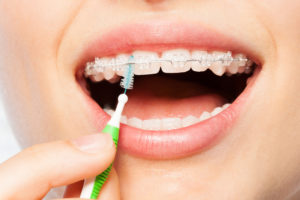
Although cleaning your teeth with braces isn’t too difficult of a process for most patients, there are some tools that you can use to better clean around the hard-to-reach areas in your mouth and make your time cleaning more efficient. First and foremost, make sure that you (or your child) are brushing after each meal. It may seem insignificant, but brushing after you eat removes food particles that are stuck in braces, reduces staining and prevents bacteria buildup. Secondly, use a threadable floss or floss threader to clean underneath the wire of your braces. A floss threader works by inserting the pointed end between the teeth and under the archwire. From there, move it back and forth until it is able to thread the floss between the teeth. Then, you can floss the two teeth, on either side, to remove all food that may be stuck there. If you’re having trouble with your floss getting stuck, consider using waxed floss, which slides between the teeth easier and doesn’t get snagged.
After brushing and flossing, using a proxabrush is helpful in cleaning between each bracket. Commonly referred to as an interproximal brush or “Christmas tree brush,” a proxabrush is placed between two brackets, below the archwire, and uses an up-and-down motion to remove any lodged food particles that brushing and flossing can’t get to. Clean the brackets with the proxabrush on both sides, starting either up from the bottom or down from the top, and repeat between each tooth. Another option for hard-to-reach areas is an oral irrigator, which uses a pulsating stream of water to remove plaque and food debris. Mouthwash is also a helpful tool to kill and bacteria that may have been left after brushing and flossing. For an extra clean, try using an electric toothbrush to maximize cleaning and brush those difficult areas of the mouth that are hard to reach.
Braces-Friendly Diet
The foods we eat and the diet we have affect our oral health and can interfere with orthodontic appliances. Eating sugary or starchy foods can let plaque develop around the brackets, which can lead to cavities, staining or even gum disease. Sticky or chewy foods, such as caramel, taffy, chewing gum and corn on the cob, should also be avoided as they can easily become stuck between brackets and be difficult to remove. Hard foods, such as candy, beef jerky, nuts and popcorn, are also no-nos as they are known to break wires and loosen brackets. If you’re going to eat hard or crunchy foods, such as apples or carrots, make sure to cut them into small, bite-sized pieces to avoid any possible damage.
Regular Orthodontic Checkups
Even if you or your child are following these rules, it is essential that you visit with your orthodontist regularly so that they can monitor teeth movement and adjust any wires or brackets. Your orthodontist or hygienist can show you how to use the tools previously described and give you additional teeth cleaning supplies to aid you during treatment. For more questions about how to clean your teeth with braces or what foods to stay away from, contact Belmar Orthodontics at (303) 225-9016!
Dental Emergencies With Braces

Braces are incredible devices that can help transform your teeth and reshape your jaws. However, they are not always fool-proof. Every so often, a patient will have a dental emergency. That may be a bad cavity that needs to be fixed, or a bracket or wire will break. There are only a few dental emergencies that can happen with braces. We can help you to know what to do when each of those emergencies happen!
Origins of Braces
Orthodontic treatments have been around for a long time-even as far back as the ancient Egyptians! Although their ways were archaic, people for centuries have been trying to fix crooked teeth and develop a prettier smile through orthodontic work. The ancient Greeks, Romans, and Etruscans were known to have practiced orthodontia, and interestingly, the Etruscans used to attach gold bands to women’s teeth to preserve the position of their teeth after death. Orthodontics saw a surge in progress during the 18th century thanks to Pierre Fauchard. Known as the “Father of Dentistry,” he invented an appliance called a bandeau, which was a horseshoe-shaped piece of metal with regularly spaced holes that fit around the teeth to correct the alignment. He would also use forceps to physically realign teeth into their correct positions and tie them to neighboring teeth until they healed.
Orthodontics in the United States exploded during the 19th century. J.S. Gunnell created a type of headgear that fashioned to the head and exerted a soft pull on teeth while Charles Goodyear invented vulcanized rubber which would eventually become one of the most commonly used appliances in orthodontics. But Edward Hartley Angle, the “Father of Modern Orthodontics,” took orthodontics to another level by identifying the true properties of malocclusion, or misalignment, and addressed them with his own set of orthodontic appliances in 1880. Until the 1970s, orthodontist would attach anchored brackets around each tooth with winding wires, but with the invention of dental adhesives, orthodontists could then stick the brackets to teeth surfaces. Stainless steel then replaced gold and silver as the most popular option for wires, due to its manipulability, and became the most cost-efficient option for braces.
Dental Emergencies and What To Do About Them
Braces have come a long way since their beginnings many centuries ago, but as braces have evolved, so have the problems that come with them. Although dental emergencies are few and far between when it comes to braces, there are some common issues that can be readily addressed and fixed if serious enough. The least serious issues that you can have with your braces is tooth tenderness and lip and cheek sores. As your teeth become accustomed to your braces, your teeth will most likely be sore for 2-4 days. Using headgear, rubber bands, and springs can add to this soreness, but that discomfort normally goes away in the same amount of time. Eating soft foods and taking an over the counter pain reliever can help dull the ache. Loose or broke bands and brackets are also another annoyance that sometimes occur with braces. Although not considered an emergency, they normally break due to patient’s eating prohibited foods or picking at their braces. Whenever this occurs, place a piece of wax on the spot of irritation and wait until your next orthodontic appointment, unless the broken bracket breaks on one of the upper or lower front four teeth, then call your orthodontist as soon as possible.
Protruding wires are not only bothersome, but can stab the inside of your lips and mouth if not fixed. Wires can come loose from eating sticky foods, like candy, or by picking at your braces. If this has occurred, try using a Q-tip or pencil eraser to push the wire in towards the teeth. To avoid accidental damage to the wire, make sure to not bite your nails or pens and pencils. In rare occasions, a piece of the appliance may break and be swallowed by the patient. Although alarming, keep calm and have someone look in your mouth to see if the appliance if visible. If confident that you can remove it, you may carefully attempt to do so. If you are unable to see the piece, are coughing excessively, or having difficulty breathing, that could be a sign that the piece could have been aspirated and you should contact your orthodontist immediately.
How To Protect Your Braces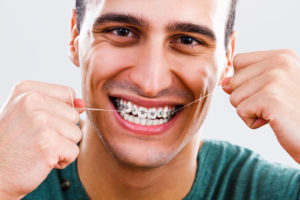
Unless under extenuating circumstances, most dental emergencies are avoidable. Maintaining good oral health and hygiene throughout your time with braces is vital in ensuring healthy teeth and gums, and preventing cavities. Food particles are easier to get stuck between braces, and when not cleaned thoroughly, can lead to other dental emergencies, like tooth decay, which can cause major complications. Hard foods, sticky foods, and foods high in sugar should be avoided as they are known to break brackets and cause cavities, which you more susceptible of developing while wearing braces. Some of the need-to-avoid foods include hard candy, nuts, apples, popcorn, ice, gum, caramel, and licorice.
Because braces are so notorious for getting food stuck in them, make sure that you are brushing after every meal to prevent staining and reducing bacteria buildup in your mouth. Use a soft brush, and brush each tooth by starting at the top and brushing down, then repeating the motion and brushing up around each bracket. Use threadable floss of a floss threader to get the hard to reach areas in between teeth that are covered by the archwire. Using the pointed end, insert between the teeth and gently move the floss back and forth between the two teeth. For added care, use a proxabrush, sometimes called a “Christmas tree brush,” to scrub between each bracket in an up and down motion to get any extra gunk that might be stuck there. For any dental emergencies that you might be having, make sure to contact Belmar Orthodontics at (303) 225-9016 for your next consultation!
Lingual Braces: History and Benefits

Several decades ago, traditional metal braces were the only option available for patients to get a beautiful, straight smile. However, the traditional take on braces changed when lingual braces were introduced. These are metal braces that go in your mouth, except they are bonded to the back of your teeth instead of the front. This option is a popular one for teens and adults, as they can hide their metal braces in their mouth as they straighten the teeth.
What Are Traditional Metal Braces?
Metal braces are “traditional” because the bracket-and-wire design they have has been used for decades. Before 1970, orthodontists anchored metal brackets to the center of each tooth and wound wires around the teeth to straighten them. After 1970, orthodontists continued to use metal anchorage devices (called brackets) on the front and center of each tooth.
A metal archwire was sufficient for straightening when it ran along the upper and lower jaws across the front of the teeth. Traditional braces use a system of archwires and brackets that are bonded to the teeth to shift them into their ideal position. When we see you at your frequent checkups, we will adjust the archwire, which will exert more pressure on your teeth, moving them in place.
The back molars will have metal bands that fit all the way around the back molars of the teeth. This is where the archwire will attach and be stabilized. Both top and bottom jaws will have these bands on them. The brackets on each tooth will have a rubber band around them, which are removable. They help keep your bracket hooks from catching on your mouth.
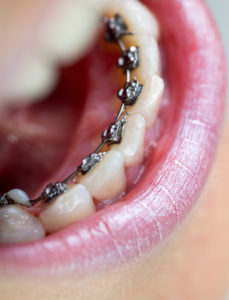
How Are Lingual Braces Different?
Lingual braces are similar to traditional metal braces. Many people don’t aesthetically like the look of metal braces, but they love their final straight smile. Metal braces are the strongest and are highly effective for achieving a beautiful smile. What can patients do if they want a straight smile but they don’t want braces front and center? Put that metal on the inside of the mouth between the teeth and the tongue!
Lingual braces are metal braces just like the traditional version, except that they are on the tongue-side of your teeth. However, there isn’t as much room on the back of your teeth like there is on the front of your teeth. If you notice, there is also a bit of a curve to the back of some of your teeth. That bracket-and-wire design can’t be exactly like the traditional version, but the design can be similar.
Using the same idea as traditional metal braces, you can achieve the same results as traditional braces, only with a hidden treatment apparatus on the tongue-side of your teeth. Patients that choose this option have impressions made of their mouth that focus on the backs of their teeth. After those impressions are sent to a special lab, metal backings for the teeth are made that are then bonded to the back of your teeth. They are almost like metal coverings for the entire tooth back, and often are silver or gold in color. These metal coverings also have small metal brackets and wires that discreetly correct bite and alignment issues over time. The concept is similar, but the design is tweaked to give lingual braces the same stability as traditional metal ones.
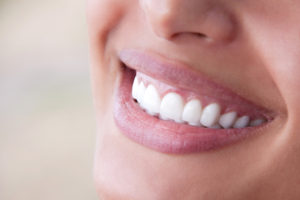
The Invention of Lingual Braces
- The push for hidden braces first started in the 70s with celebrities and public figures that wanted straighter teeth without visible metal braces.
- Craven Kurz and Jim Mulick were the first to develop prototypes for these braces in 1975. Craven Kurz was an orthodontist who later founded the American Lingual Orthodontic Association. Jim Mulick was the man Kurz partnered with from the UCLA School of Dentistry.
- The first prototypes of lingual braces led to tongue irritation and bracket breaks, which were resolved by inventing an inclined plane for these braces.
- Lingual braces are usually made of stainless steel, but they can also be made out of titanium.
- Craven Kurz applied for a patent in 1976 and the first lingual braces were produced in 1979. Ormco was the company Kurz partnered with that eventually created 7 different generations of lingual models until the current model.
- Each model involved changes to the orthodontic appliance including the additions of hooks and crannies, anterior and molar brackets and hooks, inclined planes, torque values, transpalatal bar hooks and a heart-shaped inclined plane.
- There are various designs of lingual braces that will vary based on how they look and how they are attached to the teeth. We use the “Incognito” style, but you may also hear types such as “iBraces”, “In-Ovation”, “STb Light Lingual System” and “Suresmile Lingual QT”.
How Do You Benefit?
Getting braces at all is a major step in the right direction if you want to be successful. Studies show that people who straighten their teeth often feel more confident in themselves, and their actions become more confident. Due to social, economic or aesthetic concerns, many patients may have the desire to straighten their teeth, but they don’t want to have metal braces on their teeth. For adults with careers or active social lives, they may view traditional metal braces as something only children and teens have.
However, at least 1/4th of patients with braces are adults. You simply may not see those braces because they have invisible braces like lingual braces. Lingual braces can achieve the same effect as regular metal braces without being seen. For a career setting, you can keep your white smile as it slowly becomes straighter overtime. For athletes, there isn’t a worry about dental injuries, as brackets and wires won’t cut up the cheeks or gums. Those who play wind instruments will find that lingual braces are much easier to play with than traditional braces. You get both the aesthetic appeal with sturdy straightening power with lingual braces. If you would like your free consultation, call Belmar Orthodontics today at (303) 225-9016!
Parts of Braces and Their Importance
What role does each part of braces play? The brackets, bands, wires and even our oral health guidelines all play a vital role to the health of your teeth and the success of your teeth straightening. Braces have been perfected over the years to provide you various options for teeth straightening through traditional metal braces, lingual braces, ceramic clear braces, Invisalign and more. These options weren’t available in years past, and each option has been perfected to provide you quick and efficient teeth straightening. Find out why each part of braces is important and what role each piece plays when it comes to your oral health.
Parts of Braces
Traditional metal braces have been around for decades. We still offer these braces because frankly, they work so well. Metal braces are also the most popular orthodontic option because they work to straighten your teeth the quickest and are the most cost-effective orthodontic option you can find. The metal we use is strong and sturdy. Metal braces are made from stainless steel, but can also be used in combination with titanium. There are three main parts of braces: the brackets, the wire, and the ligature elastics that go around the brackets:
- Brackets – These are the small metal pieces that are bonded to each tooth center using special glue. This glue ensures that the brackets stick to your teeth. The glue is gentle enough that it can be removed once your time with braces has finished. Brackets are made of stainless steel but also can be made white (tooth colored) or clear. These brackets hold the archwire for the teeth.
- Wire – This wire is actually known as the “archwire”. It is the metal wire that connects all of the brackets together in your mouth. You will have one archwire that is along the upper teeth and one that is along the lower teeth. This wire curves around the teeth and puts pressure on the teeth so that they come into proper alignment in the mouth. This is the main player that works to move your teeth in the right direction.
- Ligature Elastics – These are the rubber bands that attach the archwire to the brackets on each tooth. Without these ligature elastics, the archwire would not be sturdy and couldn’t do its job.
Additional Parts of Braces
There are more than just these three parts of braces.
- Headgear – This is an external appliance used in orthodontic care to help realign the face and jaw during your time with braces. There is retraction headgear and protraction headgear. Retraction headgear is an appliance used to retract the upper jaw. Protraction headgear moves the upper jaw forward and into proper alignment with the lower jaw. Headgear will consists of a single strap that fits around your neck and attaches to the front of your teeth. There is a second type of headgear that attaches to your braces, but the headgear has straps that fit over your head and neck. Not all patients will receive headgear unless it is really needed.
- Springs – Many braces have springs to help push and pull the teeth in the right direction. These springs generally attach to the arch wires and are located between the brackets of each tooth. The purpose of the springs are to open up or close up spaces between the teeth as they shift.
- Elastic Rubber Bands – Some patients need the additional shifting power of rubber bands to help the teeth move into place on schedule. These bands are attached to the brackets and will go from a lower tooth bracket to an upper tooth bracket. You will receive these rubber bands at your checkup and instruction for attaching your elastic bands at home until your next checkup.
Different Types of Braces
There are more than types of braces than just traditional metal ones. At Belmar Orthodontics we offer the following additional braces options:
- Incognito Lingual Braces – These braces quite literally go “incognito” as they are hidden inside your mouth. You will receive the same type of treatment as traditional metal braces. However, lingual braces are a hidden treatment apparatus on the tongue-side of your teeth. The brackets and metal are attached here and straighten your teeth without anyone else knowing.
- Invisalign – Invisalign is one of the stealthiest forms of teeth straightening. It is a series of transparent aligners customized to your teeth. You will change these aligners every 1-2 weeks until your smile is straight. They are easy to clean, easy to remove for eating and sports, and are virtually invisible in the mouth.
- Clear Ceramic Braces – Instead of metal, these braces are made from strong ceramic. They appear very similar to metal braces but are colored to match the shade of your teeth so they blend into the mouth. Even the archwires can be made white.
- Retainers – You will receive a retainer after your orthodontic braces treatment has been completed. Wearing your customized retainer is vital to maintaining a straight smile, as the teeth can quickly shift out of place. The first month is the most crucial as this is the time when your teeth will shift the most if a retainer isn’t worn.
Your Free Consultation
Keeping the parts of braces clean will greatly enhance your experience, so following our guidelines will help you find success with your orthodontic care. Proper braces appliances and all their parts will ensure that your teeth shift into perfect alignment in the least amount of time. If you would like to learn more about braces or need to schedule your appointment, call our Belmar Orthodontics office today at (303) 225-9016!

